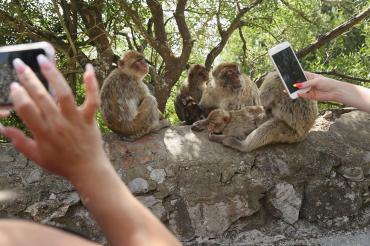The ‘perfect nuisance’: U of T researcher explores the colourful history of Gibraltar’s monkeys

Published: December 17, 2019
They may only number a few hundred, but there’s no denying the influence macaques have in Gibraltar.
Often viewed as a “perfect nuisance” to inhabitants, the monkeys that have lived among Gibraltar’s residents for the past 300 years are the focus of Monkey Tales, a new book by University of Toronto researcher Larry Sawchuk.
“These monkeys are iconic,” says Sawchuk, a professor of anthropology at U of T Scarborough who co-authored the book with his former PhD student Lianne Tripp, now an assistant professor at the University of Northern British Columbia.
“They’re so iconic that if they were ever to leave Gibraltar, it may fall from British hands. In other words, many consider that this part of the British empire rests on these monkeys.”
Sawchuk, a medical anthropologist who studies the human population in Gibraltar, has been fascinated by the macaques since he first started visiting the peninsula 40 years ago for his research. With Monkey Tales he wanted to explore what he calls the “human-monkey interface” – that is, the story of how humans and monkeys share the same space.
The Gibraltar Macaques, sometimes referred to as rock apes, are actually Barbary macaques originally from mountainous regions in Morocco. Exactly how and when they arrived remains the subject of debate, although many believe they were likely brought over by the Moors. What is known, however, is that the macaque population had already been established by the time the British captured Gibraltar in 1704.
Sawchuk says the monkeys became so important to British interests that by the early 20th century their care was entrusted to the army. Not only was each macaque given a serial number, they were also given a name.
“These names would be associated with someone of stature in British society. You had an Elizabeth, named after the future Queen, and Winston, after Winston Churchill,” says Sawchuk.

Barbary apes perch on a railing as the Queen and Duke of Edinburgh visit them on the Rock of Gibraltar during their Royal tour of the Commonwealth in 1954 (photo by PA Images via Getty Images)
Feeding and caring for the monkeys was done by a team of individuals led by the “keeper of the apes.” Many held their jobs for decades, including Alfred Holmes, a sergeant of the Gibraltar Regiment. By age 40, Holmes had spent nearly half his life caring for the monkeys. He developed a unique perspective on the monkeys that included insights on their habits and personalities that he described in human terms.
“Ape personalities are sharply differentiated as those of humans,” he wrote in 1946. “[Take} Monica for instance. A sweeter nature you could not hope to find, always cheery an ‘appy to ‘elp the other fellow. Now Wendy, she is just the opposite – sully, selfish and always me, me, me.”
Despite official efforts to care for the monkeys, Sawchuk says they gained a reputation as a “perfect nuisance” for Gibraltarians.
“The macaques can be little rascals, as monkeys tend to be. They can be aggressive and bite, damage property and steal food,” he says.
Another problem was the effect they had on the water supply. Since there are no rivers, streams or freshwater wells in Gibraltar, inhabitants were forced to harvest rainwater through rooftop catchments. Not only was macaque feces contaminating the water, they were also physically damaging the catchments.
“You have this duality where at one level you can walk down the street and the monkeys are cherished as the thing to see. On the other hand, they’re a bit of a nuisance,” he says.

Sergeant Alfred Holmes shares food with a macaque (photo courtesy of Alfred Holmes)
Much of the macaque’s history revolves around the conflict between public calls to exterminate the monkeys and those who wanted to conserve them. Today, because of better management policies and control, it’s a lot harder to spot them on the streets – yet they remain the only wild population of monkeys in Europe. They’re also the top tourist attraction in Gibraltar, with droves of people flocking up the rock to get an up-close look.
Monkey Tales weaves together a rich tapestry of sources from the archives in Gibraltar, the National Archives in London, and from the U of T Libraries, which provided invaluable documents dating back to the early 1800s.
Documentation on the macaques stretches back three centuries, showing how popular they were in the public imagination ever since the early years of British occupation in Gibraltar. Their popularity and importance also resulted in likely one of the earliest official forms of primate conservation in the empire.
“These monkeys were important to the colonial authorities for a number of reasons,” says Sawchuk, noting that as pets they helped to escape boredom, but also offered the prestige of experiencing the presence of monkeys on the continent of Europe.
“We’d like to think of it as one of the earliest signs of conservation practice in the British empire – and it was mostly done because these monkeys were an important symbol of British-ness.”



